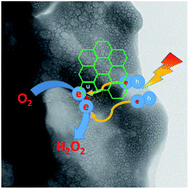Nitrogen-doped graphene/graphitic carbon nitride with enhanced charge separation and two-electron-transferring reaction activity for boosting photocatalytic hydrogen peroxide production†
Abstract
Strong photo-generated charge recombination within graphitic carbon nitride and the lack of suitable co-catalysts with selective high catalytic reaction activity have hindered the effective photocatalytic hydrogen peroxide production. In this work, a series of 2D co-catalyst nitrogen-doped graphenes with the different bond states of doped nitrogen were synthesized under modified synthetic conditions, resulting in different surface catalytic hydrogen peroxide generation activities. Electrochemical analysis proves that pyrrolic nitrogen doped in graphene plays an important role in improving two-electron-transferring reactions on the surface of nitrogen-doped graphene for hydrogen peroxide generation, which depresses further reduction of hydrogen peroxide into hydroxyl radicals. Benefiting from the synergistic role of improved charge separation and enhanced surface-selective reaction activity of the co-catalyst nitrogen-doped graphene, 2D/2D graphitic carbon nitride/nitrogen-doped graphene heterostructure composites produce 56.22 μmol hydrogen peroxide under visible light irradiation in 4 h, which is 2.77 times higher than the 20.28 μmol of pure graphitic carbon nitride.



 Please wait while we load your content...
Please wait while we load your content...